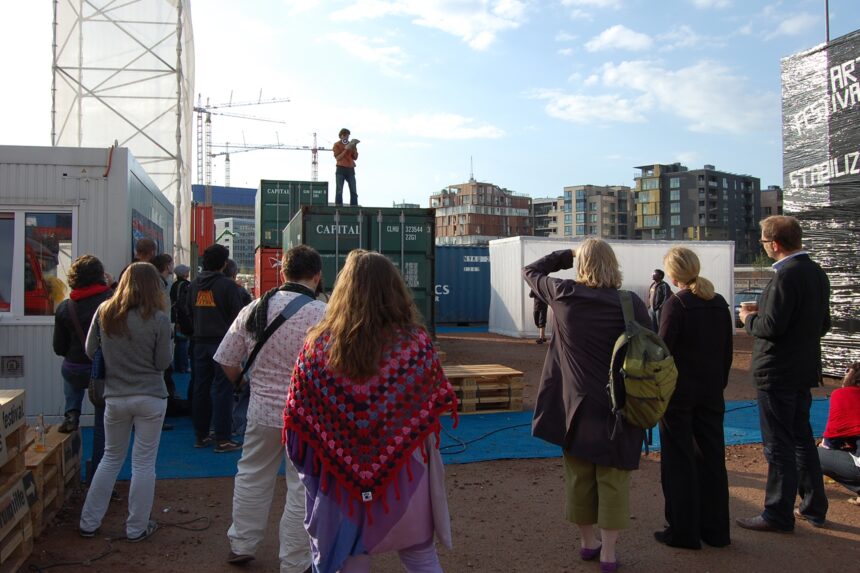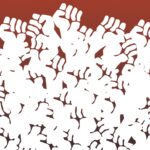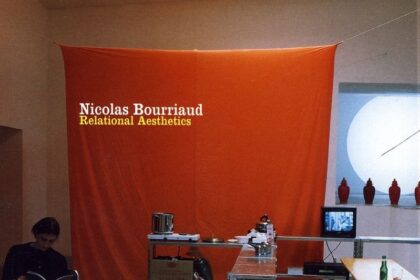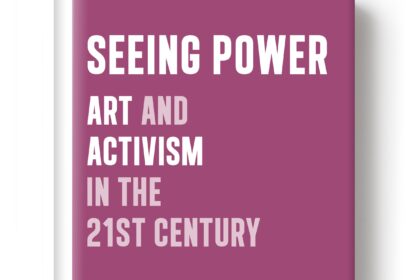Book Review: John Roberts, Revolutionary Time and the Avant-Garde (London: Verso, 2015)
Noni Brynjolson
In Revolutionary Time and the Avant-Garde, John Roberts defends a concept of the avant-garde rooted in Marxist theory and reworks it in order to take into account shifts in contemporary art towards the conceptual, the collaborative and the everyday. Roberts is Professor of Art and Aesthetics at the University of Wolverhampton, England, and his research focuses mainly on the relationship between art and politics. He has written about the role of the philistine in aesthetic theory, representations of the everyday in art and the role of photography as an oppositional practice. In his most recent book, Roberts focuses his attention on the avant-garde and aligns himself with other critics working to salvage its political potential (the majority of whom are male––an issue worth further analysis).[1] This attempt to refunction the term is something of a daunting task.
As many art historians have pointed out, the mid-twentieth century saw the avant-garde merge with the canon of modern art and become fragmented and weakened through decades of postmodern criticism that pointed out its failure to remain un-coopted, questioned its presence as a heroic master narrative, highlighted a multiplicity of geographically dispersed avant-gardes and shed light on a range of identity-based social signifiers that claimed equal footing with class disparity. From a contemporary perspective it can be difficult to disentangle the avant-garde from notions of progress and aesthetic autonomy, which clash with recent shifts towards cultural democratization that promote the Beuysian idea that ‘everyone is an artist.’ In addition, most contemporary artists would not use ‘avant-garde’ to describe their work without a sense of irony. The term exists in our collective mindset mainly as an art historical concept, evoking Courbet’s self-identification as a member of the working classes, the radical abstraction of Malevich or the communal practices of Die Brücke.
The 1960s saw the emergence of the neo-avant-garde, in which the energy of unrealized utopian political aspirations was absorbed by poststructural theory. In a 2010 essay, Peter Bürger responded to criticism of his book Theory of the Avant-Garde (1984). Reflecting on the period in which it was written, he described a sense of failure associated with the aftermath of May 1968 and wrote about the transfer of practice into theory, which for him at the time “seemed to be the key that could keep open the door to the future that I imagined…as a finally livable world.”[2] Our contemporary understanding of the avant-garde has its roots in the utopianism of events such as the Paris Commune, Russian Revolution and May 1968. These events are important historical markers for recent theorists of aesthetic autonomy, for whom the concept is a defense against the constant threat of co-optation posed by neoliberal culture.
These are the problems that the avant-garde must face today in order to be refunctioned for contemporary art and aesthetics. Roberts uses his adept command of critical theory to present a nuanced account of the current relationship between art and politics, revolving around the concepts of aesthetic autonomy and negation. He argues that an updated avant-garde must stand in advance of bourgeois culture, meaning and values—it must be an art “in advance of capitalism.”[3] This argument highlights some of the main features of the historic avant-garde, including the notion that art possesses a unique potential premised on critical distance from everyday life. The gap or space that is implied here also emphasizes the experimental nature of the avant-garde and its ability to test out new ideas in a zone free from compromise and bias. ‘In advance’ implies distance as well as externality, two characteristics that enable avant-garde artists to supposedly see past the confines of everyday life under capitalism, expose the untruths of neoliberalism and create revolutionary change. The idea that art possesses an innate criticality that is capable of posing a challenge to the capitalist domination of society is worth defending. But it is also worth thinking through the extent to which, in laying the groundwork for such a challenge, Roberts and other current theorists of the avant-garde structure their arguments around autonomy and negation, drawn primarily from the critical theory of Adorno and other Frankfurt School theorists.
Roberts’ understanding of political transformation is premised on Hegel’s concept of absolute negation. For Roberts, any concept of the avant-garde that lacks or abuses this principle will be incapable of developing an authentic sense of aesthetic autonomy, thereby foreclosing a full understanding of the dialectical relationship between art and life. He uses the terms ‘first negation’ and ‘second negation’ to refer to this process. First negation refers to art’s autopoeisis, which involves the way in which it becomes marked off from everyday life and takes on a determinate commodity form that can be transmitted and reproduced. Following this, Roberts writes that second negation involves “the leap to freedom through the negation of the negation that Hegel understood as the force of liberation immanent to human subjectivity and to human praxis and which he termed Absolute negativity, and that is identifiable here with revolutionary cultural praxis (absolute negation).”[4] Roberts points to Marx’s adaption of Hegelian negation, in which the struggle of workers directs the dialectical process and opens up a new relationship between theory and practice. He offers the examples of Russian Constructivism and 1960s conceptual art as moments when first and second negation occurred and autopoiesis merged with political resistance in the name of the revolutionary transformation of society.
It is this second negation, and its emergence in forms of contemporary art, that leads Roberts to think a refunctioned avant-garde might be possible, since it involves a dialectical interplay between art and the social. However, he cautions that “Hegel’s impatient servants of second negation”[5] risk skipping the crucial step of first negation, thereby dissolving art into the social without a fully defined sense of autonomy. He argues that the avant-garde must be viewed as a ‘suspensive’ category, which means that “any identification of it with a premature escape into politics and instrumental reason––irrespective of art’s alignment with political praxis, or with the ‘end of art’, or with art’s embrace of non-artistic practices and disciplines)––dissolves its non-identitary functions and ambitions.”[6] The view of political or activist art as premature is often repeated by contemporary theorists of the avant-garde who rely on concepts of Hegelian negation, in which theory remains a privileged site of experimentation while practice is construed as impatient or misguided.
Adorno’s Aesthetic Theory (1970) is a key reference point for Roberts’ notion of a refunctioned avant-garde. This must necessarily take into account the current field of ‘art after art in the expanded field,’ as Roberts refers to it––a terrain that includes a range of post-conceptual art practices such as relational and digital art. Adorno wrote Aesthetic Theory after experiencing fascism in Europe and witnessing the totalitarian aftermath of the Russian Revolution. He was critical of the German state during its reconstruction after the Second World War, and viewed art as a realm that must always remain separate from a totally administered society. For Adorno, art that created actual social change in the world risked complicity with the instrumentalizing powers of growing state bureaucracies. He argued that a strong defense of aesthetic autonomy was the only way to preserve art’s political powers of negation. Modern art must exist solely for itself and must resist bourgeois cravings for “a sort of use-value modeled on sensual pleasure.”[7] Viewing the modern world as dominated by utility, he believed that the utopian function of art should be to resist the objectification, commodification and alienation associated with capitalist reproduction.
Adorno comes up repeatedly in Revolutionary Time and the Avant-Garde, and in other books by Roberts as well. In 2002, Roberts and Dave Beech wrote several essays on the philistine that were collected and published, along with a series of responses, in a book called The Philistine Controversy.[8] In it, they argued that the philistine does not possess an innate culture of his or her own, but instead, is a position defined through class division and exclusion from the realm of fine art. They also wrote about the ways in which a further theorization of philistine modes of attention could play a role in unsettling the boundaries of traditional aesthetic discourse and potentially create a more permeable border between art and non-art.
Beech and Roberts’ discussion of the philistine was one of many debates that would follow over the next decade relating to cultural democratization and deskilling in art. Greg Sholette has written about this as well and uses the term ‘dark matter’ to refer to activist art and tactical media practices that fly under the radar of the official art world.[9] Referencing Sholette’s book, Roberts discusses art’s ‘second economy’ in a similar light and looks at its relationship with the avant-garde. The second economy of the art world is made up of individuals and groups who tend to work outside mainstream channels of artistic production and exchange: artists who are unemployed or underemployed, amateurs, hobbyists and art students, for example. As Roberts points out, it is the space where the majority of artists now labor. He argues that in the face of artistic movements towards the everyday, the social and the popular, it is more important than ever for art to maintain and defend a sense of its own autonomy and that this involves a negation of the values of profit and status that define the first economy (characterized by salesrooms, auction houses, museums and large public galleries, according to Roberts). It is important to Roberts that art is understood as a distinct form of labor set apart from the practices it represents or comments upon and as not subject to the alienating, reifying tendencies of work under capitalism. While art might comment on design, fashion or theory, for example, it must maintain critical distance in order to resist morphing into those disciplines. In other words, for Roberts, art must operate within the everyday but maintain its outsider status “in order for autonomy to do its work of revision, extraction, subjection, subtraction, negation, etc.”[10]
Roberts goes into detail in discussing two projects that he views as demonstrating aspects of a refunctioned avant-garde: the British conceptual group Art & Language, active during the 1960s and 70s, and the Russian group Chto Delat, formed in the early 2000s (Chto Delat? was the title of Lenin’s 1902 text advocating for a professional revolutionary class that would overthrow the Russian monarchy). Roberts views Art & Language as coming out of a moment in Britain when post-minimalism was shifting towards conceptual art and an autonomous zone of art practice was understood as a defense against the bourgeois values associated with American modernism. This was catalyzed by a growing awareness of Soviet and European avant-gardes that had been obscured or omitted from art history up to that point and that offered inspiration and legitimation. Roberts views this as a moment in which the first negation of autopoeisis––form becoming autonomous––moves outwards to act in and upon the world. As in the historic avant-garde, this is a moment that he views as possessing the potential to reinvigorate art practice and produce social transformation.
This is a fascinating point, but the actual social transformation produced by the group is unclear here. Instead, it seems that its significance lies mainly in the lineage of art theory and is more akin to commentary or investigation than action. Like much conceptual art, the work of Art & Language was focused on questioning the boundaries of art, highlighting power structures in the art world and undermining modernist or bourgeois notions of subjectivity and authorship. For Roberts, the group demonstrates the ‘suppression of the beholder’ tactic common within conceptual art, as well as a new conception of collective intellect built around the scriptovisual, which “defines the possibility of a new sociality for art not on the basis of a programme of social intervention, but on the basis of extending the work of reception as a theoretical dialogue. In this the scriptovisual possesses a negating force: it sets out to turn away those who are not willing to engage in the given terms of the theoretical exchange.”[11] He discusses Art & Language’s commitment to collaboration and collective intellect as a means of restructuring modernist artistic subjectivity, but with the caveat that their practice was premised on theory as allegory. Similarly to the historic avant-garde, viewers needed to possess a certain level of artistic awareness or aesthetic education in order to fully comprehend or participate in the work.
Analyzing Art & Language in Britain allows Roberts to formulate a vision of the avant-garde in relation to conceptual art of the 1960s, in which modern artistic subjectivity, collaborative practices and political commitments in art were being reworked. Chto Delat offers a more contemporary example––the collective of artists and writers is based in Moscow and St. Petersburg and formed in 2003 in the context of the increasing privatization of the Russian economy. Roberts considers their work to be influenced by relational art in France but sees it as shifting away from the neo-avant-garde associated with Bourriaud and moving towards a revolutionary mode rooted in the historic Soviet avant-garde. Drawing from Hal Foster’s critique of Bürger in Return of the Real (1996),[12] Roberts refers to their practice as exemplifying a ‘belatedness,’ which involves reworking an original idea in a different time and context. One of the projects organized by the group is a collectively written newspaper, Newspaper of the Engaged Platform, Chto Delat/What is to be Done?. They aim to take up the unfinished project of the historic avant-garde, much of which has passed into the realm of a depoliticized national culture. In addition to the printed newspaper, their work has included videos, installations and performative interventions in public spaces, influenced by the practices of Bertolt Brecht and Augusto Boal. Roberts emphasizes that their work draws on the eroded, yet still embedded histories of the Russian avant-garde and describes its potential to “expose the impostures and political weaknesses of global neoliberal power.”[13] He discusses the staged nature of their performances and interventions, which demonstrate “a key aspect of what they do not want the political agency of the avant-garde to be seen to be doing: to embed itself completely in the heteronomous particulars of the everyday as form of post-autonomous, instrumentalized practice.”[14] Roberts does not include much detail on specific performances or discuss the audience reception of Chto Delat’s work, nor does he consider what they might have produced in terms of actual social transformation. Instead, the performative act is valued on its own as a kind of revolutionary utterance. He views their work as illustrative of the ‘suspensive’ avant-garde, which possesses the quality “of being both in the world and athwart it”[15] and is therefore able to avoid the “instrumental-activist shift”[16] associated with post-relational aesthetics, including various forms of social practice.

[Illustration 1. “Illegal Migrant,” performance by Chto delat/What is to be done?, on top of the installation “Offshore/Onshore” by Zoro Feigel from De Service Garage (Amsterdam, NL), 2009. Subvision Art Festival, Hamburg, Germany. Photo: Jennifer Smailes.]
The examples provided by Roberts point to the importance of considering new theories of the avant-garde in relation to socially engaged art, much of which might be defined as ‘instrumental-activism’ in Roberts’ account. Many words have been exchanged on the benefits and/or pitfalls of referring to social practice as art. Roberts’ position seems to be that without a well defined sense of aesthetic autonomy, such work is fated to disintegrate into life: it becomes part of the indefensible zone of social welfare work associated with non-profits, benefits creative entrepreneurs or generally works alongside rather than in advance of capital. Greg Sholette has commented on the problem of avant-garde collapse as well, writing that “if art has finally merged with life as the early 20th Century avant-garde once enthusiastically anticipated, it has done so not at a moment of triumphant communal utopia, but at a time when life, at least for the 99.1%, sucks.”[17] What Roberts and Sholette make clear is that art’s dissolution into life and the social is not an inherently political gesture—hence, Roberts’ argument that an updated avant-garde must stand in advance of capitalism. But one problem with this position is that many ‘heteronomous’ practices move imperceptibly both in and out of the spheres of art, life and the social, to the degree that ontological boundaries have become blurred beyond recognition. This poses a problem for a good deal of current art theory devoted to defending the political potential of the avant-garde, in which critics focus on weeding out vulgar, non-art or activist art practices that are seen as compromised and corrupted as soon as they leave the protected world of aesthetic autonomy.
Hegel’s writing stressed the conflict and antagonism at the heart of subjectivity and our relationships with others. This accounts for some of the bias towards negation present within contemporary critical theory, including Roberts’ defense of the avant-garde and its reliance upon a model of oppositional autonomy. In this account, the task for art is to undo meaning and deconstruct power, not to test out or practice models of social change that might alleviate social conditions––thereby becoming complicit with capital. In Aesthetic Theory, Adorno laid out a vision of aesthetic autonomy that both strengthened art as a form of critical theory and defanged it as a form of political practice. In drawing upon these sources, Roberts theorizes a refunctioned avant-garde that stands in advance of capitalism but lacks the ability to act in the present moment.
In contrast, Stephen Wright argues in Toward a Lexicon of Usership (2013) that “the price to pay for autonomy [is] the invisible parentheses that bracket art off from being taken seriously as a proposition having consequences beyond the aesthetic realm.”[18] Wright also envisions a refunctioning of the current theoretical frameworks that structure contemporary art, but he takes a different approach from Roberts. Instead of a model of autonomy premised on negation, he sees the possibility for a different understanding of art that shifts the focus away from ontological boundaries and towards attention and activation, in part through the use of Duchamp’s notion of “art coefficients”: the recognition that “art is not a set of objects or events, distinct from the larger set of objects and events that are not art, but rather a degree of intensity liable to be present in any number of things indeed, in any number of symbolic configurations, activities or passivities.”[19] While Wright is not necessarily writing about art in advance of capitalism, his discussion of coefficients offers an alternative to understanding the political nature of art as tied to autonomy. Instead, he emphasizes the actual moments in which ideas or forms are taken up by a group of ‘users’ and become meaningful. The concept of ‘coefficients’ also allows a rethinking of Roberts’ focus on dissolution; instead of seeing art as merging seamlessly with life in social practice-type work, the value of describing such projects as art is in the potential to frame a particular set of issues through varying intensities of attention and activation and to test out different practicable models of sociability and activism.
Revolutionary Time and the Avant-Garde is an important read for those interested in the critical potential of contemporary art, and in current debates about the relationship between art and politics. The critical potential of art––and its ability to interpret and envision the world differently––is worth defending, and Roberts’ book is a passionate defense of these principles, laid out in impeccable detail and with a great amount of theoretical complexity and inventiveness. In drawing from Hegel and Adorno, he outlines several of the critical frameworks that could be described as stumbling blocks in current theories of socially engaged art. In doing so, he offers readers a chance to think through the roles that negation and autonomy might play in refunctioning the avant-garde and contributing to a shared project of social transformation.
Noni Brynjolson is a PhD student in Art History, Theory and Criticism at the University of California, San Diego.
Notes
[1] A partial list of critics who have recently written about the avant-garde includes Marc James Léger, Gene Ray, Gerald Raunig, Mikkel Bolt Rasmussen, Brian Holmes, Greg Sholette and Borys Groys. Léger has edited several books that reconsider the avant-garde; see Brave New Avant-Garde (London: Zero Books, 2012) and The Idea of the Avant Garde: And What It Means Today (Manchester: Manchester University Press, 2014).
[2] Peter Bürger, “Avant-Garde and Neo-Avant-Garde: An Attempt to Answer Certain Critics of Theory of the Avant-Garde,” New Literary History 2010 (41): 698.
[3] John Roberts, Revolutionary Time and the Avant-Garde (London: Verso, 2015), 31.
[4] Ibid., 59.
[5] Ibid., 61.
[6] Ibid., 15.
[7] Adorno, Aesthetic Theory (Minneapolis: University of Minnesota Press, 1997), 14.
[8] Dave Beech and John Roberts, The Philistine Controversy (London: Verso, 2002).
[9] Greg Sholette, Dark Matter: Art and Politics in the Age of Enterprise Culture (London: Pluto Press, 2011).
[10] Ibid., 110.
[11] Ibid., 152.
[12] Hal Foster, Return of the Real: Art and Theory at the End of the Century (Cambridge, Mass.: MIT Press, 1996).
[13] Roberts, 176.
[14] Ibid., 177.
[15] Ibid., 178.
[16] Ibid., 178.
[17] Greg Sholette, “Delirium and Resistance after the Social Turn,” FIELD: A Journal of Socially Engaged Art Criticism, Spring 2015.
[18] Stephen Wright, Toward a Lexicon of Usership (Eindhoven: Van Abbemuseum, 2013), 12.
[19] Ibid., 13.











